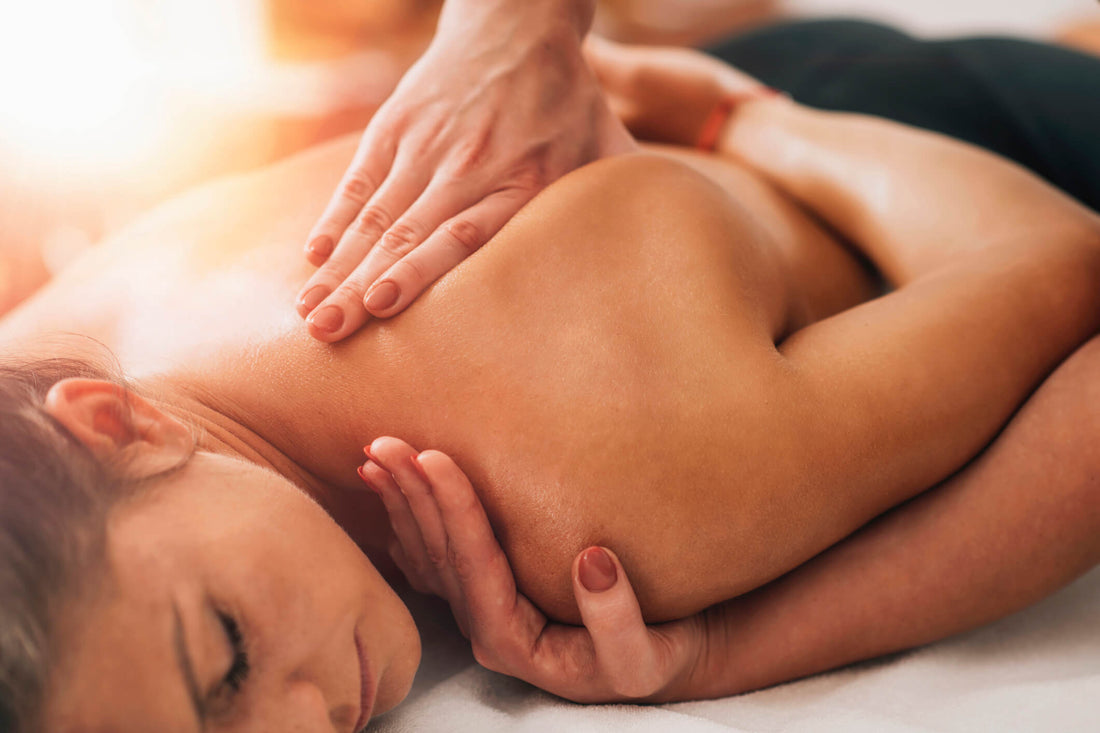
The Best Massage Pressure: Why "No Pain, No Gain" Is Wrong
When getting a massage, how often do you suffer through pain and discomfort under the proviso it’s doing you good? Furthermore, are you putting up with next-day soreness as a badge of honour?
From what I've come to understand clinically as a Physiotherapist, there's a pervasive culture around massage that suggests harder means better. But does it?
In some instances, deeper pressure may be warranted, but my work has taught me that the best massage is not a one-size-fits-all approach. Whether you're recovering from injury, improving performance, or just looking to relax, an effective massage must be tailored to your individual mental and physical needs - needs that can change between sessions. Otherwise, we can easily compromise your experience and recovery goals.
If you’d like to learn what the best massage should look like for you and why harder doesn't always mean better, read on.
Key Takeaways:
- Next-day soreness is often a sign of application error, not effectiveness.
- Your brain's perception of threat (pain) plays a huge role in how your body responds to massage.
- Effective communication with your therapist is the most critical factor for a successful massage.
- Self-massage tools can provide effective maintenance between professional sessions.
What Is Massage Therapy?
Massage is a treatment technique used to manipulate the body's soft tissues. It's most commonly performed by the hands, but forearms, elbows, feet, and other treatment devices can also be used.
By varying the technique, we can utilise massage to achieve different goals, making it a versatile tool for:
- Treating pain and injury
- Part of a warm-up or cool-down routine
- Next-day recovery
- Promoting relaxation
Benefits of Massage
This versatility is thanks to its numerous well-understood benefits, which include:
- Increased local blood flow
- Reduction in stress and anxiety
- Muscle relaxation and reduced tension
- Improved soft tissue mobility
- Pain reduction
- Improved removal of metabolic waste and swelling
- Supporting lymphatic drainage
- Improving sleep quality
- Expediting recovery post-injury
Potential Side-Effects of Massage
As with any treatment, there can be side effects. It's important to distinguish between normal sensations and signs of a poor application.
- Increased pain during or after treatment
- Temporary next-day soreness (similar to DOMS - Delayed Onset Muscle Soreness)
- Flare-up of an existing injury or symptoms
- Increased swelling
- Bruising
- Neck pain or headaches due to positioning on the table
Interestingly, significant side-effects usually have more to do with application error rather than massage itself. It's inherently safe in experienced and communicative hands.
Common Types of Massage
Here are some of the most recognisable types of massage, each with a different primary goal:
- Sports Massage: Aims to improve athletic performance and recovery. It is often deeper and more focused on specific muscle groups. It can be part of remedial therapy.
- Trigger Point Therapy: Uses constant, direct pressure on hyperirritable spots (knots) in muscle to prompt reflexive relaxation and pain relief.
- Relaxation (Swedish) Massage: Uses lighter, flowing strokes to promote overall relaxation of the nervous system and body.
- Lymphatic Drainage: A very light, rhythmic massage designed to assist the body in removing excess swelling and congestion.
- Active Release Therapy (ART): A movement-based technique used to address adhesions in muscles, tendons, and ligaments.
Despite their differences, one key point remains: to best meet your goals, a massage must be tailored specifically to you. It should be an ongoing collaboration, not a dictated set of techniques.
Why We Think Incorrectly About Massage
As a Physiotherapist, I hear everyone's opinions on massage. A common and problematic perception is that you haven't had a "good" massage until you've been put through significant discomfort. Many people seek a hard massage and expect next-day soreness to feel like they're 'doing something good.'
This idea perpetuates the view that a softer massage is 'worthless' and can even create a stigma where people who prefer lighter pressure are seen as having a low pain tolerance.
This thinking needs to change.
We can do better. We need to shift from "harder means better" to a more skilled and balanced approach that requires conversation and adaptation from both therapist and client. Otherwise, we are missing the point of massage entirely.
How to Receive the Best Massage: A Practical Guide
Getting the most out of your massage starts long before you get on the table. Follow these steps for a better, more effective experience.
1. Communicate Clearly and Early
This is the most critical factor. It's okay to speak up. If your massage feels too hard or too soft, it probably is.
- Set ground rules before you start: Tell your therapist, "Please check in on pressure, and I'll let you know if anything is too much." This makes feedback expected and welcome.
- Use a pain scale: Tell your therapist, "On a scale of 1 to 10, where 1 is no sensation and 10 is unbearable pain, I'd like to stay around a 6 or 7." This gives them a clear, objective target.
2. Understand Pain and Its Role
This may surprise you, but a good understanding of pain can transform your massage experience. Pain is your brain's interpretation of threat, not just a response to tissue damage. You can have severe pain without significant injury, and you can have an injury with little pain.
In the context of a deep massage, anything that further challenges an already threatened nervous system has the capacity to increase your pain and the risk of post-treatment soreness. If the pressure makes you tense up or hold your breath, your brain is perceiving a threat, which can counteract the massage's benefits.
3. Master Your Breathing
Your breath is a direct window into your nervous system. Pay attention to it during your massage.
- If the pressure is too deep, you'll likely find yourself holding your breath or breathing shallowly.
- Consciously practice slow, deep breaths. This signals to your brain that you are safe, fostering an efficient environment for tissue release and making the massage more effective.
4. Remember: Muscles Are Tight for a Reason
A tight muscle is not just a lifeless knot. It's an adaptive piece of machinery controlled by your brain and nervous system. Muscles generally become tight for two main reasons:
- To protect and support underlying dysfunction or injury (e.g., your hamstrings tightening to support an unstable lower back).
- Being consistently placed in shortened positions (e.g., hip flexors from prolonged sitting).
Any attempt to release muscle tightness must respect the reason it's there. A brutal massage that ignores the protective function can often make the underlying issue worse.
How to Give Yourself an Effective Self-Massage
While professional massages are fantastic, frequent sessions can be expensive. Self-massage with tools is an excellent way to maintain your tissue health between appointments.
Think of your hands as a guide, and use tools to provide the pressure. A massage ball or foam roller can be just as effective as a set of hands for many techniques.
- Constant Pressure (Trigger Point): Place the ball on a tender spot and apply steady, tolerable pressure. Hold for 30-60 seconds, breathing deeply, until you feel the tissue begin to release.
- Shearing/Gliding: Place pressure through the tool and move it slowly across the muscle fibres, not just along them. This can help address adhesions.
How to Reduce Your Need for Massage
Massage is great, but it's often a short-term solution. It addresses the symptom (tightness) but not always the cause. To create lasting change, ask yourself these questions:
- Why are you stressed? Is it work-related? Deeper than that? Addressing the source of stress is more effective than constantly managing its physical manifestation.
- How and how much do you sit? If your neck, shoulders, and back are constantly tight, poor sitting posture is a likely culprit. Improve your workstation ergonomics and take regular movement breaks.
- What shoes do you wear? Shoes with a heel shorten calf and Achilles tendons, leading to tightness over time.
- Is your core stability sufficient? Your spine is your body's foundation. If your core is weak, your body will recruit other muscles (like your glutes and hamstrings) to stabilise, leading to compensatory tightness.
Frequently Asked Questions
Is it normal to be sore after a massage?
Mild, next-day soreness can occur, similar to how you might feel after a good workout. However, significant or painful soreness is often a sign that the pressure was too intense for your body's current state. The goal of a massage is not to create pain, and consistent, severe post-massage soreness is a sign to communicate your pressure preferences more clearly with your therapist.
What type of massage is best for relaxation?
For pure relaxation, a Swedish or relaxation massage is typically the best choice. It uses lighter, flowing strokes that are designed to calm the nervous system and promote a state of peacefulness, without the deep pressure that can sometimes be stimulating or uncomfortable.
How often should I get a massage?
This depends entirely on your goals. For general wellness and stress relief, once a month can be sufficient. If you are dealing with a specific injury or training for an athletic event, you may benefit from more frequent sessions, such as weekly or bi-weekly, as advised by your physiotherapist or massage therapist.
Conclusion
The culture of "no pain, no gain" has no place in massage therapy. The best massage is an intelligent, collaborative process that respects your body's current state and nervous system. By prioritising clear communication, understanding your body's signals, and ditching the misconception that pain equals gain, you can transform your massage experience from a painful ordeal into a truly therapeutic and beneficial treatment.
How do you prefer your massage pressure? Let me know in the comments below!
Need Personalised Guidance?
If you'd like help trying to uncover the underlying cause of your pain or dysfunction, consider booking an online Telehealth consultation with Grant here!

